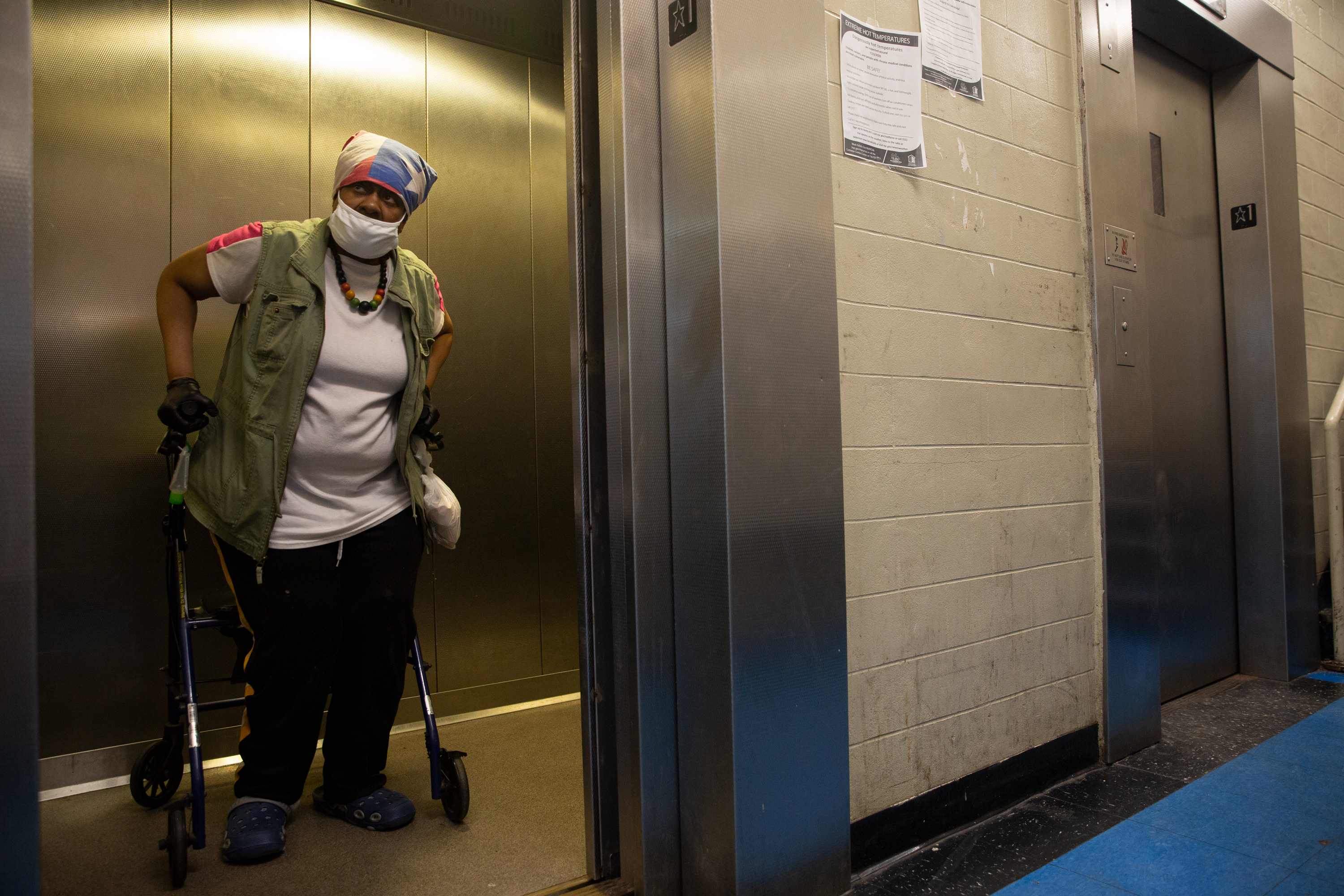by Greg B. Smith, THE CITY

This article was originally published
on
by THE CITY
On a recent June afternoon, an ambulette crew dropped off 68-year-old Jacquelyne Pierre at her building in Brooklyn’s Walt Whitman Houses after she’d finished an exhausting session of dialysis.
But there was one problem — or rather, two.
Both elevators were out of service and Pierre, who uses a cane, lives on the ninth floor.
The ambulette driver and a helper initially stayed with Pierre, still strapped to a stretcher, as tenants frantically called NYCHA to send repair staff. But nobody came, and after an hour, the ambulette team transferred her to a folding chair, put a white sheet over her legs, and left her in the lobby.

“She sat down there for hours and hours,” recalled a neighbor, Eileen Boyce, 71. “A neighbor went upstairs and got food for her. Her granddaughter brought down a bottle of cold water. I stood with that lady.”
As the day headed toward sundown and no repair crew had showed up, Pierre’s relatives wound up picking her up and carrying her up the stairs.
Less Maintenance, More Outages
On July 31, Pierre said, it happened again.
“I have my dialysis. I come back. I sit down,” she recalled Thursday. “Police come and talk to me. Seven o’clock, eight o’clock, nine o’clock. The police called the Fire Department and they carried me up the stairs. Every day there’s a problem with the elevators.”
The public housing tenants of the Whitman Houses, in Fort Greene, say the lifts go out frequently, and repair crews sometimes take days to get them back up and running. A few days later, the “fixed” elevator goes out of service again.

And during the COVID-19 pandemic, the problem only got worse across the 320 NYCHA complexes housing 400,000 New Yorkers — more than one in five of them senior citizens, a review by THE CITY found.
Struggling to contain the spread of the virus, NYCHA cut back on preventive maintenance of its 3,193 aging elevators — with planned outages for elevator work dropping nearly a thousandfold between April and late June because of the pause.
Meanwhile, unplanned outages rose.
And by May, NYCHA didn’t have enough staff in its elevator unit to keep up, and was forced to rely on unskilled laborers to help out.
A Pre-Pandemic Warning
The warning alarms were blaring, even before the arrival of the coronavirus.
In January, the federal monitor overseeing NYCHA red-flagged the authority for failing to keep up with preventive maintenance of its elevators. Because NYCHA didn’t have enough repair staff, workers would run from outage to outage, skipping preventive fixes the monitor called “crucial.”
In a Jan. 30 report, NYCHA monitor Bart Schwartz noted that “reductions in elevator mechanics and helpers have strained [the elevator unit]’s coverage, often delaying or deferring preventive maintenance that could inoculate the elevator from future problems.”
At the time, NYCHA promised to hire more staff. But those plans were put on hold when the pandemic struck.
Exacerbating the problem, NYCHA discovered it didn’t have enough elevator helpers — trained staff who monitor shutdowns while mechanics fix the lift — to accompany mechanics, as required by law.
‘Serious Concerns’
In May, NYCHA quietly began assigning laborers to do this job. NYCHA managers say the laborers were given 30 days of training.
But officials at Teamsters Local 237, the union that represents 8,000 NYCHA workers, noted that helpers are required to complete a three-year apprenticeship to qualify for the job title.
A lawyer for the union, Marty Glennon, raised this issue with NYCHA Chairman Gregory Russ in a May 29 letter obtained by THE CITY, asserting that the use of laborers with such limited training presented potential dangers.
‘The union has raised serious concerns (about) inexperienced city laborers working as elevator mechanic helpers.’
“The union has raised serious concerns with a representative of the NYCHA concerning inexperienced city laborers working as elevator mechanic helpers at several of the NYCHA locations,” Glennon wrote.
A NYCHA lawyer, John Bilancini, informed the union that the authority had tried to fill the positions with qualified helpers. But, he said, NYCHA was forced to use laborers because the Department of Citywide Administrative Services (DCAS) had not established an active civil service list.
Carl Gilles, director of Local 237’s housing division, said NYCHA wound up relying on laborers due to “poor planning on the part of the Housing Authority, who knew almost a year ago that they were running out of mechanic helpers and should have been scouting and preparing prior to this.”
Major Maintenance Drop
In response to questions from THE CITY, NYCHA spokesperson Barbara Brancaccio emailed, “If laborers do not meet the standards or fail to meet the safety and job understanding, they will be released from their duties.
“Laborers were hired because we could not find qualified helpers and needed staff with a similar skill set,” she added. “If we did not utilize laborers our staffing levels would be diminished and our ability to provide services would be hampered.”
Since March, as the number of COVID-19 positive began to skyrocket in New York City and citizens were told to shelter in place, the number of tenants using the elevators decreased, and at first, so did the number of outages, according to NYCHA.
The number of planned elevator outages fell from 9,600 to 10.
But to help reduce the spread of the virus between workers and tenants, the authority also cut back drastically on planned elevator shutdowns for preventive maintenance. Between April 1 and June 24 of last year, the number of preventive work orders fell from 9,624 to 8,290, while the number of planned elevator outages fell from 9,600 to 10.
After the COVID-19 numbers peaked in early April, the number of outages per week began to climb. The week of April 5 brought 429 outages system wide. By the first week of May the figure reached 543 outages, and by the first week of June the toll hit 747. It has dropped slightly since.
NYCHA had expected the overall number of outages would drop significantly because of what it predicted would be less usage during the pause. But the number of outages from April 1 through June 24 instead rose from 6,784 last year to 6,830 during the same period this year.
Demands for Accountability
Tenants at the Whitman Houses described a troubling of cycle of repairs followed by outages, followed by repairs, followed by outages.
“What is going on is they are not really maintaining it,” said Boyce, a third-floor resident who relies on the elevator because she needs a motorized scooter to get around. “They do come out, but they really don’t fix it. They get it to run for a little bit. It’s running but who knows how long it will last.”

Early last week, one of two elevators in her building was, once again, out of service, but it was repaired by Wednesday. Meanwhile, both lifts inside a building across the courtyard at Whitman went out for five hours early Wednesday, NYCHA records show.
And during a 24-hour period Wednesday and Thursday, those records also show 177 buildings across NYCHA had at least one non-operational lift, sometimes for more than a day. At the Wagner Houses in Lower Manhattan, the lifts in one building were out for 175 hours, the records show.
“These people need to be held accountable,” Boyce said. “Somebody is going to have a heart attack.”
THE CITY is an independent, nonprofit news outlet dedicated to hard-hitting reporting that serves the people of New York.











More Stories
Two south Florida men plead guilty in $35M COVID scam
Pelosi’s home district is a progressive nightmare
Louisiana lacks transparency for COVID relief spending